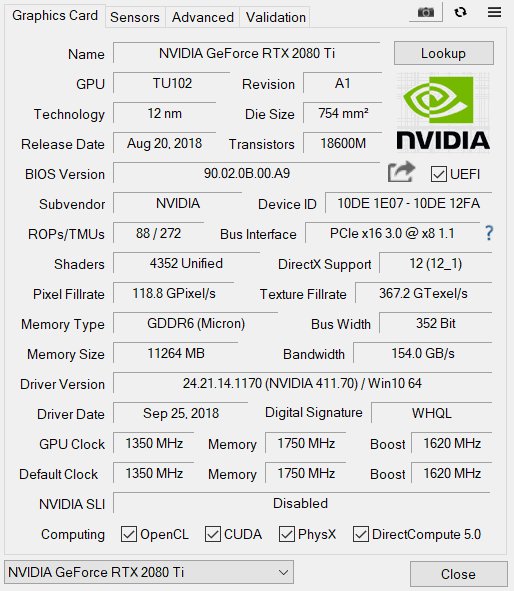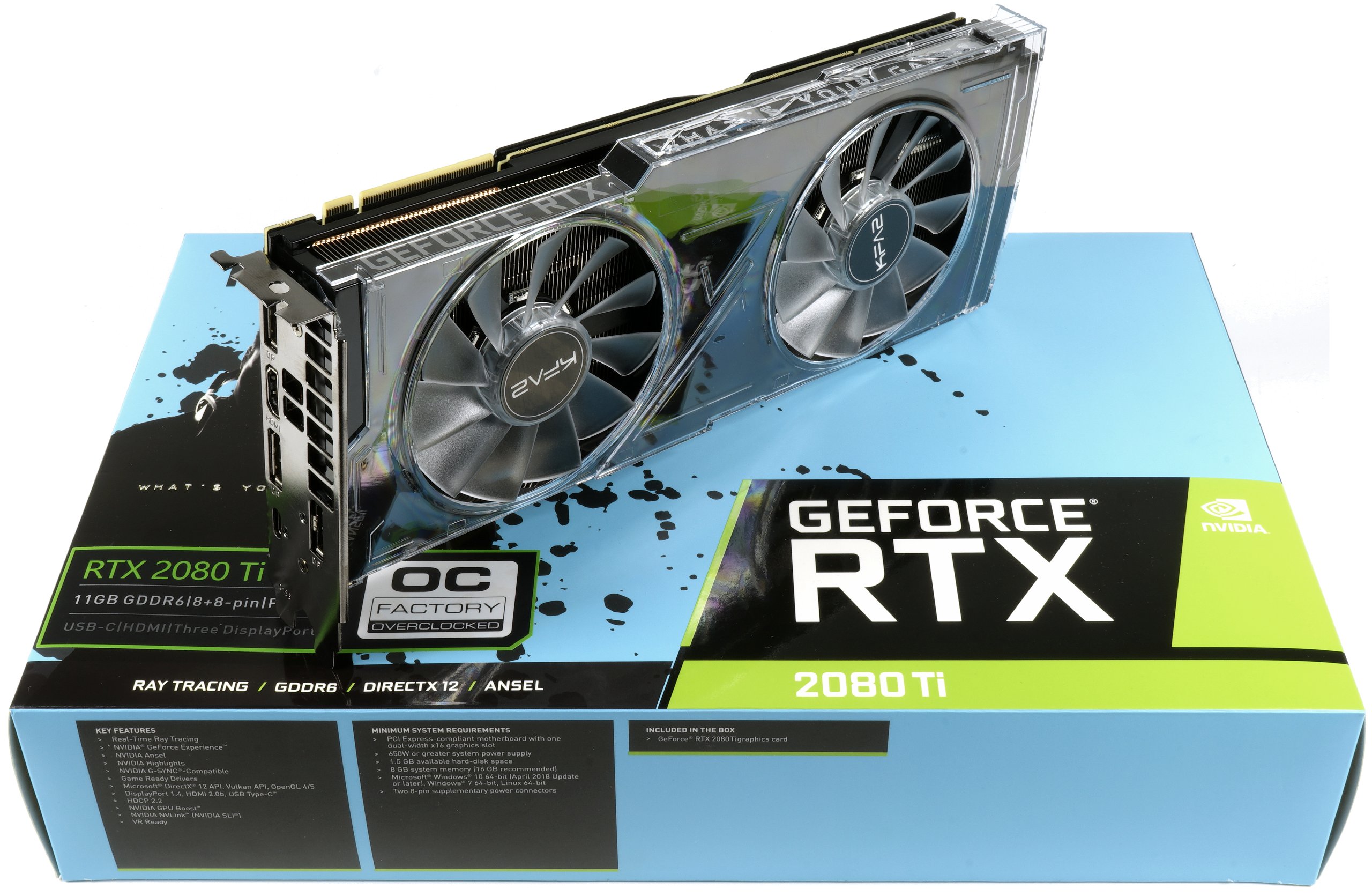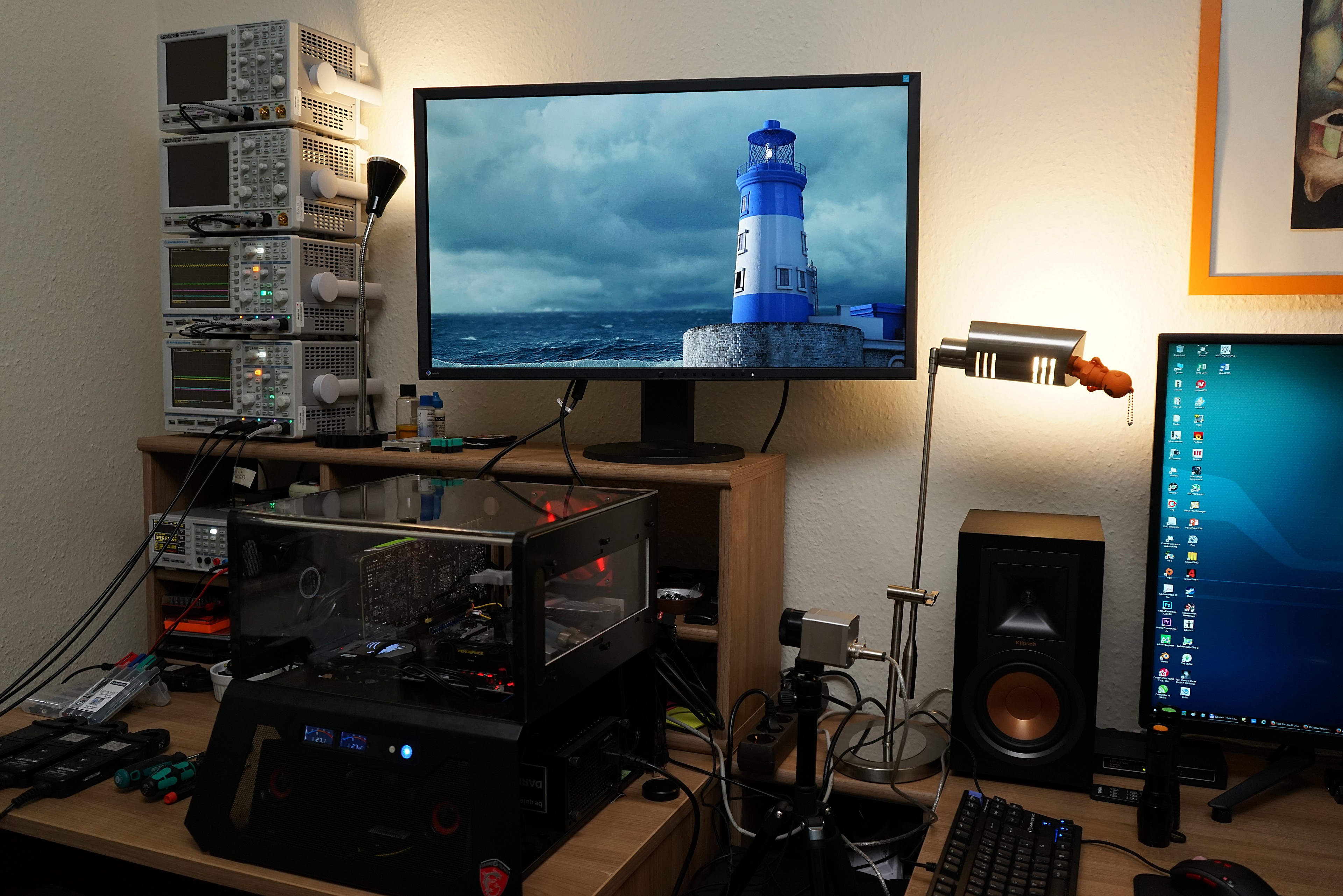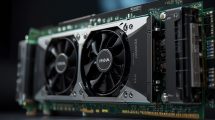KFA2 has designed a current Turing card with the very simple GeForce RTX 2080 Ti OC, which could be considered a real Janus head. What makes the card very interesting for a very specific target group is its first BIOS, which I will discuss in more detail later. Since this card, however cynical it may sound, is one of the rather "cheap" GeForce RTX 2080 Ti, you will of course quickly reach thermal, acoustic and nervous limits with a rather small and light dual-slot cooler, as well as the two 8.5 cm fans.
Physics is a very solid science that cannot be tricked. But, and here one should read this article to the end, it also has advantages, which we can still highlight in another follow-up to a certain cooling method. But later on at the relevant places more. It is also important to note that I was in close contact with KFA2 after this review and that the manufacturer has now developed a new BIOS, which will also be taken over into mass production.
Important preliminary remarks on the test
The card tested today has a BIOS, the power target of which is 320 watts ex works and can be raised to the maximum power limit of 380 watts with suitable software. For air coolers like these, this interpretation is simply unsuitable, but highly interesting for all water cooling enthusiasts. Even if it's an original Nvidia PCB, this board can be flashed freely, which is definitely not possible with the Founders Edition of Nvidia right now!
KFA2 will soon deliver this card with another BIOS, whose values of 260 watts (out of the box) and a maximum of 300 watts are roughly what the Founders Edition offers. This air cooler tested here is again fully in the race, so that I can in any case offer a detailed post-test. I have already been able to test the new BIOS for a short time and it does exactly what the reduction was intended to do. So please stay tuned.
Unboxing and functionality
At 1150 grams, the card is quite light, which doesn't have to be negative yet, but already gives a glimpse of certain things. At 27.3 cm, it is also quite short and measures only 11.3 cm from the top edge of the slot panel to the top edge of the graphics card case. As a real dual slot card it is only 3.3 cm thick and the 0.5 cm for the backplate could be saved, because it could be removed quite easily. The card has a fan cover made of transparent ABS, which is illuminated by the RGB LED on a large area. You can like it or not.
Otherwise, the map is visually more of a grey mouse when you turn off the illumination. If you like it nicely colorful, you will be able to celebrate real RGB parties here.
KFA2 delivers the card with two external 8-pin ATX power supply connectors. This card has a maximum power limit (not to be confused with the Power Target) of 380 watts in the firmware, which would call into question the supply in that one of the supply rails would run above the specifications. I'll get to that later.

Technical data and comparison maps
At the end of this introduction, the maps of the new generation and those of the old generation in direct tabular comparison:
| KFA2/Galax GeForce RTX 2080 Ti Oc |
Nvidia GeForce RTX 2080 Ti Fe |
Nvidia GeForce RTX 1080 Ti Fe |
Nvidia GeForce RTX 2080 Fe |
Nvidia GeForce RTX 1080 Fe |
|
| Architecture (GPU) |
Turing (TU102) | Turing (TU102) | Pascal (GP102) | Turing (TU104) | Pascal (GP104) |
| CUDA Cores |
4352 | 4352 | 3584 | 2944 | 2560 |
| Peak FP32 Compute |
14.2 TFLOPS |
14.2 TFLOPS | 11.3 TFLOPS | 10.6 TFLOPS | 8.9 TFLOPS |
| Tensor-Cores |
544 | 544 | No | 368 | No |
| RT-Cores |
68 | 68 | No | 48 | No |
| Texture Units |
272 | 272 | 224 | 184 | 160 |
| Basic clock |
1350 | 1350 MHz | 1480 MHz | 1515 MHz | 1607 MHz |
| Boost clock |
1620 | 1635 MHz | 1582 MHz | 1800 MHz | 1733 MHz |
| Memory |
11GB GDDR6 | 11GB GDDR6 | 11GB GDDR5X | 8GB GDDR6 | 8GB GDDRX5 |
| Storage bus |
352-bit | 352-bit | 352-bit | 256-bit | 256-bit |
| Memory bandwidth |
616 GB/s | 616 GB/s | 484 GB/s | 448 GB/s | 320 GB/s |
| Rops |
88 | 88 | 88 | 64 | 64 |
| L2 Cache |
5.5MB | 5.5MB | 2.75MB | 4MB | 2MB |
| Tdp |
300w | 260W | 250w | 225W | 180w |
| Transistors |
18.6 billion | 18.6 billion | 12 billion | 13.6 billion | 7.2 billion |
| Chip size |
754 mm2 | 754 mm2 | 471 mm2 | 545 mm2 | 314 mm2 |
| SLI Support |
Yes (x8 NVLink, x2) | Yes (x8 NVLink, x2) | Yes (MIO) | Yes (x8 NVLink) | Yes (MIO) |
Test system and measurement methods
We have already described the new test system and the methodology in detail in the basic article "How We Test Graphics Cards, as of February 2017" and therefore refer to this detailed basis for simplicity. Description. So if you want to read everything again, you are welcome to do so. However, we have again improved CPU and cooling to largely exclude possible CPU bottlenecks for this fast card.
If you are interested, the summary in table form quickly provides a brief overview:
| Test systems and measuring rooms | |
|---|---|
| Hardware: |
Intel Core i7-6900K -4.5GHz MSI X99S XPower Gaming Titanium G.Skill TridentZ DDR4 3600 1x 1 TByte Toshiba OCZ RD400 (M.2, System SSD) 2x 960 GByte Toshiba OCZ TR150 (Storage, Images) Be Quiet Dark Power Pro 11, 850-watt power supply |
| Cooling: |
Alphacool Ice Block XPX 5x Be Quiet! Silent Wings 3 PWM (Closed Case Simulation) Thermal Grizzly Kryonaut (for cooler change) |
| Housing: |
Lian Li PC-T70 with expansion kit and modifications Modes: Open Benchtable, Closed Case |
| Monitor: | Eizo EV3237-BK |
| Power consumption: |
non-contact DC measurement on the PCIe slot (Riser-Card) non-contact DC measurement on the external PCIe power supply Direct voltage measurement on the respective feeders and on the power supply 2x Rohde & Schwarz HMO 3054, 500 MHz multi-channel oscillograph with memory function 4x Rohde & Schwarz HZO50, current togor adapter (1 mA to 30 A, 100 KHz, DC) 4x Rohde & Schwarz HZ355, touch divider (10:1, 500 MHz) 1x Rohde & Schwarz HMC 8012, digital multimeter with storage function |
| Thermography: |
Optris PI640, infrared camera PI Connect evaluation software with profiles |
| Acoustics: |
NTI Audio M2211 (with calibration file) Steinberg UR12 (with phantom power for the microphones) Creative X7, Smaart v.7 own low-reflection measuring room, 3.5 x 1.8 x 2.2 m (LxTxH) Axial measurements, perpendicular to the center of the sound source(s), measuring distance 50 cm Noise in dBA (Slow) as RTA measurement Frequency spectrum as a graph |
| Operating system | Windows 10 Pro (1803, all updates) |












































Kommentieren